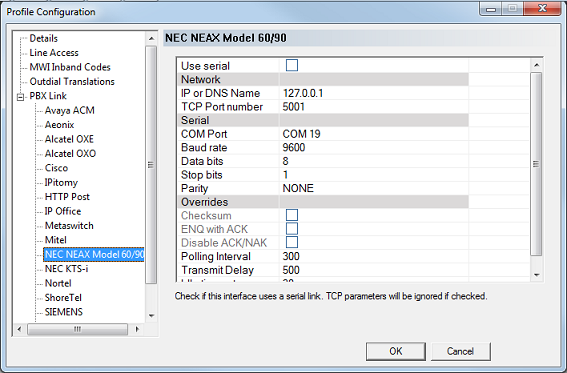NEC NEAX Model 60/90
The DuVoice 7.00 can link to an NEC SV9300 / SV9500 PBX using either a serial connection or a TCP connection where the PBX is the server/host. This link uses the protocol and features listed in the table below:
| Link Type | Protocol Used | Log File Prefix | Features Supported |
|---|---|---|---|
| Serial, TCP client | NEC NEAX Model 60 or 90 | NEAX | Check In, Check Out, Room Move, Name Change, Maid Status, Controlled Restriction, Language, DND, MWI, VIP |
This page is used to configure the 7.00's link to the PBX.

The settings are grouped into three categories: Network, Serial and Overrides, plus one general setting. Configure the settings as needed and then click OK to save your changes and close the dialog. Or click Cancel to discard any changes and close the dialog.
General Settings
| Setting | Default | Description |
|---|---|---|
| Use serial | Disabled | If the PBX connection is serial, check this box to enable the serial setting. If it is a TCP link, leave the box unchecked. |
Network Settings
| Setting | Default | Description |
|---|---|---|
| IP or DNS Name | (blank) | Enter the IP address or DNS name for the PBX. Required if using TCP. According to the NEAX protocol specification, the PBX is always the server. |
| TCP Port number | 5001 | Enter the port number to listen on for connections from the PBX. |
Serial Settings
| Setting | Default | Description |
|---|---|---|
| COM Port | COM1 | Select the COM port to which the serial cable is connected. Options include: COM 1 through COM 255. Which ports are actually valid depends on the hardware installed (or connected) and the Windows configuration. |
| Baud rate | 9600 | Set the value to match the setting on the PBX. Options include: 300, 1200, 2400, 9600, 19200, 38400, 57600, and 115200. |
| Data bits | 8 | Set the value to match the setting on the PBX. Options include: 5, 6, 7, and 8. |
| Stop bits | 1 | Set the value to match the setting on the PBX. Options include: 1 and 2. |
| Parity | None | Set the value to match the setting on the PBX. Options include: None, Odd, Even, Mark, and Space. |
Overrides
| Setting | Default | Description |
|---|---|---|
| Checksum | Enabled | For serial: Set to enabled because the NEAX protocol uses checksums over a serial link. For TCP: This setting is ignored because checksums are not supported over TCP by the NEAX protocol. |
| ENQ with ACK | Disabled | Set to enabled if the voice server should always respond to ENQ with ACK. Set to disabled if the PBX sends an ENQ to request that the voice server repeat its last ACK/NAK response. The NEAX protocol indicates the latter usage, so this setting should be disabled. If using a TCP connection, this setting is ignored as ENQ is not supported over TCP by this protocol. |
| Disable ACK-NAK | Disabled | For serial: Must be set to disabled because the NEAX protocol requires ACK-NAK responses over a serial link. For TCP: This setting is ignored because the NEAX protocol does not support ACK-NAK responses over a TCP link. |
| Polling Interval | 60 | Enter the number of seconds to wait between polling (keep-alive) messages. Ideally, this should not be less than 60 seconds unless the PBX requires it. |
| Transmit Delay | 500 | Enter the time, in milliseconds, that the voice server should wait after sending a message (and receiving the ACK response) before it can send another message. The default is 500 ms (half a second). If the PBX is getting overwhelmed, you can increase this value to artificially slow the pace of message traffic. |
| Idle timeout | 30 | Enter the maximum time, in minutes, the port can be idle before the port (or the PBX link service itself) is reset. A port is considered idle if no input is being received. The purpose of this feature is to force a port reconnection if it appears the link has been dropped or is otherwise not functioning even though it otherwise appears to still be connected. If polling is enabled, this must be set to a value larger than the polling interval. Note, however, that this value is specified in minutes while the polling interval is specified in seconds. Set to 0 if you wish to disable this feature. |